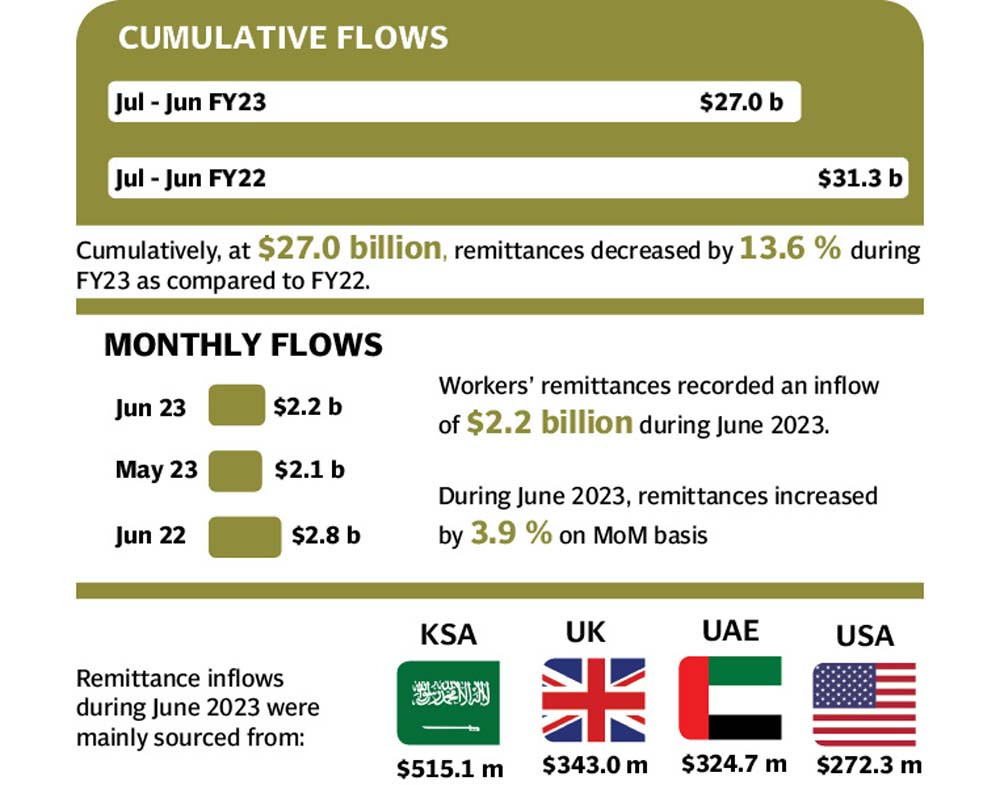Remittances decline by 14% in FY23
Drop to $27 billion as illegal markets offered favourable exchange rates

The inflows of workers’ remittances sent home by overseas Pakistanis experienced a significant slowdown, declining by 14% to a cumulative $27 billion in the previous fiscal year that ended on June 30, 2023. The availability of a more favourable rupee-dollar exchange rate in illegal markets diverted the flows away from legal channels, impacting the country’s foreign exchange reserves, which currently stand critically low at $4.4 billion. The government has responded by implementing import controls to ensure the timely repayment of maturing foreign debt.
The State Bank of Pakistan (SBP) reported on Monday that non-resident Pakistanis had dispatched a record-high $31.3 billion in fiscal year 2022.
In June, the final month of FY23, remittances saw a 4% improvement hitting $2.2 billion compared to $2.1 billion received in the month of May 2023. Expatriates sent higher funds to their family members to celebrate Eidul Azha, which fell in the last week of the month. However, remittances for the month witnessed a 22% decline compared to the month last year.
Former director of research at Topline Securities, Yousuf M Farooq explained that “The government’s interventions in (legal) currency markets from time to time during the year kept creating differences in the rupee-dollar exchange rates between legal and illegal markets.”
“The availability of better exchange rates in the illegal hawala-hundi market attracted a section of overseas Pakistanis resulting in them sending funds through this channel to Pakistan,” he said.
During the year, the exchange rate gap widened to approximately Rs30 per dollar, impacting the inflows of workers’ remittances. Farooq noted that the slowdown in remittance inflows was mainly recorded from Middle Eastern countries such as Saudi Arabia and the United Arab Emirates (UAE), where hawala-hundi operators are present. In contrast, inflows remained comparatively better from compliant Western countries such as the United States (US) and the United Kingdom (UK).
Political and economic uncertainties also played a role, as non-residents opted to send only essential amounts to their relatives in their homeland. The uncertainties may also have led to a reduction in investment volumes in the real-estate and property sectors this year, he said.
Farooq mentioned that the difference in exchange rates narrowed down two to three weeks ago after Pakistan implemented measures to stabilise domestic currency markets, following the International Monetary Fund (IMF)’s recommendations in order to secure a newly signed $3 billion loan programme. The narrowing of the gap partially helped improve inflows for June.

design: Ibrahim Yahya
However, recent speculations suggest that the difference in exchange rates has once again widened to Rs15 per dollar on Monday. This occurred as the domestic currency dropped to Rs305/$ in the hawala-hundi market compared to Rs280/$ in the official interbank market.
The widening gap is speculated to be due to the high demand for foreign exchange to clear import backlogs, surpassing the supply of the greenback in the economy.
Farooq expressed hope that this disparity would not last beyond a brief period after Pakistan signed a staff-level agreement with the IMF for the $3 billion loan programme in late June.
“The government has to let market forces determine the exchange rate. This action will help attract higher workers’ remittances in the months to come.”
A market-based exchange rate helps bridge the gap between the demand and supply of foreign exchange in the market, improve economic output, enhance export earnings, and boost remittance inflows, Farooq explained. He further stated that stability and subsequent improvement in foreign exchange reserves, following the implementation of the IMF programme, would help eliminate illegal currency markets.
Regarding region-wise remittances, the central bank reported that inflows of workers’ remittances slumped by 20.5% to $4.65 billion in FY2023 compared to $5.85 billion in FY22. Remittances sent from Saudi Arabia reduced by 17% to $6.44 billion over the year, while those from the UK dropped by 10% to $4.05 billion. Remittances from the US saw a marginal increase of 0.1% to $3.09 billion, while remittances from other GCC countries declined by 12% to $3.19 billion. Remittances from EU countries decreased by 7% to $3.12 billion. The decline in remittance inflows raises concerns about the country’s foreign exchange reserves and the need for measures to attract higher remittances and stabilise the economy.
Published in The Express Tribune, July 11th, 2023.
Like Business on Facebook, follow @TribuneBiz on Twitter to stay informed and join in the conversation.


















COMMENTS
Comments are moderated and generally will be posted if they are on-topic and not abusive.
For more information, please see our Comments FAQ